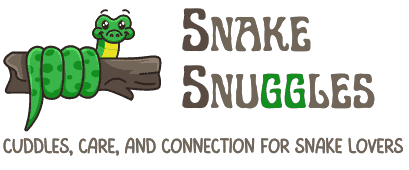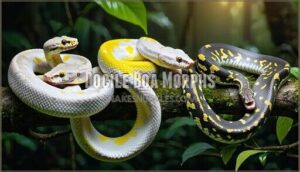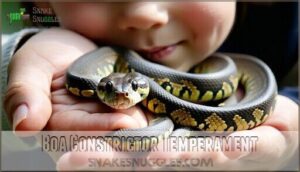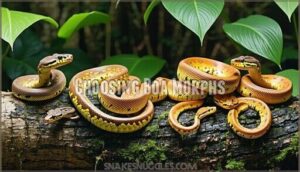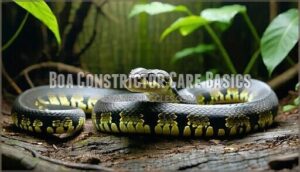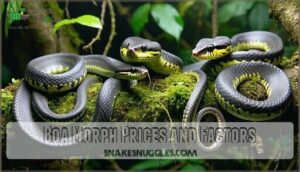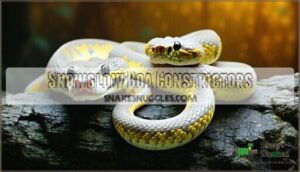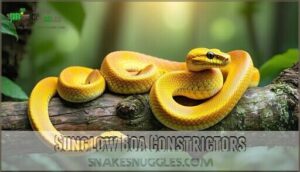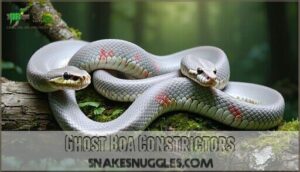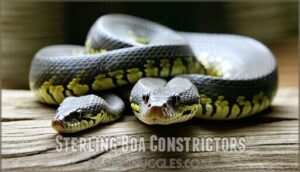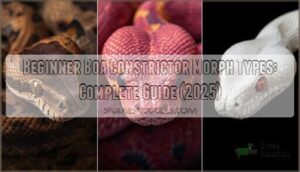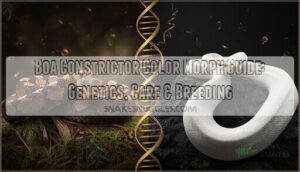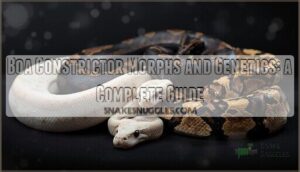This site is supported by our readers. We may earn a commission, at no cost to you, if you purchase through links.
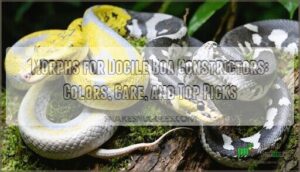
Albino boas, with their vibrant yellow and white scales, are striking yet gentle. Anerythristic morphs, featuring cool grays and blacks, have a sleek, relaxed vibe.
Arabesque boas stand out with complex, swirling patterns and are known for their manageable demeanor.
Temperament isn’t all about genetics, though—proper handling and stress-free conditions play a big role. When choosing a morph, consider color, pattern, and personality.
Ready to explore the details? There’s a world of boa beauty waiting for you, no snake charming required!
Table Of Contents
Key Takeaways
- Choose docile morphs like Albino, Anerythristic, and Arabesque for their calm temperaments and striking appearances.
- Proper handling, stress-free environments, and consistent care are key to keeping your boa relaxed and healthy.
- Rarity determines morph prices and the quality of your snake, along with breeder reputation, and genetic lineage.
- Always buy from ethical breeders to avoid health issues and ensure your boa has strong and healthy genetics.
Docile Boa Morphs
When picking a boa constrictor, you’ll want a morph with a calm, manageable demeanor.
Some of the most docile morphs, like Albino, Anerythristic, and Arabesque, combine beauty with a gentle temperament, making them great for keepers of all experience levels.
Albino Boa Constrictors
Albino boa constrictor morphs stand out with their lack of melanin, showcasing creamy white bodies and striking red eyes.
These snakes are recessive in Albino genetics, requiring two genes to express their vibrant traits.
- Found in Albino complexes like Sunglow and Snow morphs
- Known for calm, docile behavior
- Popular in boa morph care and breeding
- Easy to handle for beginners
- Influences boa morph prices
Anerythristic Boa Constrictors
Anerythristic boa constrictor morphs stand out with their silver bodies, soft lavender hues, and signature brown saddles.
The genetic absence of red pigment gives them a unique look, perfect for calm boa constrictors. Their docile temperament makes them beginner-friendly, offering a striking yet manageable pet.
| Trait | Description |
|---|---|
| Coloration | Silver, lavender hues, brown saddles |
| Size | Medium to large |
| Red Pigment | Genetically absent |
| Temperament | Calm and docile |
| Care Level | Beginner-friendly |
Arabesque Boa Constrictors
If you’re fascinated by boa constrictor morphs with intricate patterns, Arabesque Boa Constrictors stand out.
Their genetics create bold saddles and striking speckling intensity, making each unique Arabesque mesmerizing.
Known for calm boa morph characteristics, they’re a favorite among breeders.
Arabesque breeding emphasizes combining their pattern variations for stunning results.
These boas balance beauty with a docile temperament, perfect for enthusiasts.
Ethical breeding practices help guarantee these boas avoid genetic defects.
Boa Constrictor Temperament
Understanding a boa constrictor’s temperament helps you build trust and handle them safely. Their behavior depends on genetics, environment, and how often they’re handled.
Genetic Influence on Temperament
While boa morph temperament adds charm, genetics play a limited role.
Research shows no strong gene-temperament link, meaning boa genetics guide physical traits more than behavior.
Still, genetic variations like mutation effects and epigenetic factors might slightly influence boldness or calmness.
Heritability estimates remain low, but selective breeding focuses on healthy, hardy boas—not personality—a key boa morph genetics takeaway.
Environmental Factors Affecting Temperament
Your boa’s temperament isn’t just genetic—it’s shaped by its environment.
Temperature gradients, humidity levels, and proper lighting cycles are key.
Too hot or too humid? Stress can change snake behavior.
Choose an enclosure size giving room to explore and a substrate type that’s cozy yet clean.
By managing these environmental factors, you’re supporting a calm, happy boa.
Handling and Socialization
When handling your boa, always move calmly to reduce stress and promote a calm demeanor.
Start with short, frequent sessions to build trust, as easy-to-handle boas thrive on regular interaction.
Recognize cues like relaxed movements that show adaptability.
Socialization benefits include taming snakes for safe handling.
Over time, their steady nature makes them reliable companions for snake handling enthusiasts.
Choosing Boa Morphs
When picking a boa morph, focus on reputable breeders to guarantee healthy genetics and proper care.
Look for morphs with colors and patterns that match your interest while considering compatibility for breeding or keeping as pets.
Researching Reputable Breeders
When choosing boa morphs, start with reputable breeders.
Look for breeder ethics, health guarantees, and morph expertise.
Ask about lineage verification and study customer reviews.
Reliable sellers prioritize ethical breeding, ensuring healthy boa constrictor morphs, not just flashy snake morph prices.
Research their care knowledge—compassionate breeders consider boas’ needs over trends, making it safe for your collection.
Selecting Compatible Morphs
After selecting a reputable breeder, think about morph genetics and compatibility.
Dominant and recessive genes influence visual outcomes, so understanding inheritance patterns is key.
Pairing compatible morphs isn’t just smart breeding—it’s ethical. Genetic compatibility prevents defects while ensuring healthy snake morphs.
Whether it’s recessive traits or dominant traits, careful planning makes vibrant, healthy boa constrictor morphs a reality without surprises.
Considering Color and Pattern
Every boa constrictor morph tells a story through its colorful scales and unique patterns.
Explore Morph Aesthetics like brilliant Color Intensity or striking Pattern Aberrations that make each snake unique.
Genetic Combinations determine boa morph colors and patterns, creating unmatched Visual Appeal. Understanding how genetics shape every scale can help you appreciate the diversity within boa constrictor morphs.
Immerse yourself in these fascinating genetic variations to find the boa morph patterns that truly captivate your sense of style!
Boa Constrictor Care Basics
Taking care of a boa constrictor means providing a spacious enclosure, proper heating, and secure housing to match its natural habits.
You’ll also need to monitor its health, guarantee proper feeding, and maintain the right humidity levels to keep your snake thriving.
Housing and Enclosure Setup
Boas need enclosures sized appropriately—usually 4 to 6 feet long for adults—with secure lids.
Use a soft, absorbent substrate like cypress mulch or aspen. Maintain a temperature gradient, from 75-85°F, for comfort.
Consider adequate enclosure products for your boa. Provide hiding spots to reduce stress, and keep humidity levels around 50-70% for healthy skin.
A thoughtfully designed vivarium setup keeps your boa happy and thriving.
Feeding and Nutrition Requirements
Your boa’s feeding plan is key to its health.
Match prey size to your boa’s girth to avoid choking or obesity risks.
Feed younger boas weekly, adults bi-weekly.
Verify proper hydration methods, like a clean water bowl.
Supplementation needs are rare for these carnivores but watch nutrition closely!
Consider appropriate rodent sizes for ideal boa health.
A healthy boa avoids laziness and thrives long-term!
Health Monitoring and Maintenance
Healthy boas thrive with routine health monitoring.
Watch for shedding issues, respiratory infections, and scale rot. Match prey size to their girth and schedule vet checkups for peace of mind.
Ensuring proper temperature gradient is essential for their well-being.
Here’s a quick guide:
| Health Issue | Signs to Watch | Prevention Tips |
|---|---|---|
| Shedding Problems | Retained skin, dull look | Provide humidity; avoid handling |
| Respiratory Infections | Wheezing, open-mouth breathing | Maintain warmth; clean enclosure |
| Scale Rot | Discolored, soft scales | Use dry substrate; clean spills |
Boa Morph Prices and Factors
In the context of boa morph prices, rarity, breeder reputation, and genetic lineage all play a role in determining value.
Understanding these factors helps you make informed choices and avoid surprises when budgeting for your new scaly companion, considering the impact of breeder reputation.
Rarity and Demand
Boa morph rarity plays a big role in setting prices. Snake morph demand shifts as collector interest rises, leading to price fluctuations. Popularity hinges on traits, but breeding challenges keep some morphs scarce.
Here’s why prices vary:
- Rarity boosts value.
- Market trends shape demand.
- Ethical sourcing matters.
- Breeding complexity increases cost.
- Aesthetic appeal drives snake morph pricing.
The factors influencing snake morph prices are interconnected, with breeding challenges contributing to the scarcity and value of certain morphs.
Breeder Reputation and Lineage
Trusting reputable breeders guarantees ethical breeding and healthy boa constrictor morphs.
Genetic screening, health guarantees, and lineage tracking protect your investment.
Morph compatibility and line breeding shape distinct traits, but genetic diversity avoids issues.
Take note:
| Feature | Why It Matters | How It Helps |
|---|---|---|
| Ethical Breeding | Avoids genetic defects | Promotes healthy boas |
| Lineage Tracking | Verifies morph pedigree | Ensures authenticity and breeding value |
| Health Guarantees | Covers unforeseen health issues | Provides peace of mind |
The table outlines key features that matter when considering boa constrictor morphs, including lineage tracking and health guarantees.
Genetic Lineage and Heritage
Morph origins reveal how genetic mutations shape boa appearances.
Line breeding refines traits but risks reducing genetic diversity, so ethical breeding is key.
Trait inheritance depends on dominant and recessive genes, with inheritance patterns guiding morph genetics.
Tracing heritage ensures quality and health, making it vital to know your boa’s lineage before buying.
Understanding dominant and recessive genes is essential for predicting offspring traits.
It’s like finding treasure, and knowing the lineage is crucial for a healthy boa.
Popular Docile Boa Morphs
If you’re looking for boa constrictors with mild temperaments, certain morphs stand out for their beauty and ease of handling.
These snakes combine striking genetic traits with a gentle nature, making them great choices for responsible owners.
Snowglow Boa Constrictors
Snowglow boas blend Albino and Anery genetics, creating pale yellows with white hues that seem painted by nature.
Snowglow boas dazzle with soft white and pale yellow tones, embodying nature’s artistry in every scale.
These boa constrictor morphs are as enchanting as they’re fascinating.
To embrace Snowglow husbandry:
- Maintain proper enclosure humidity.
- Provide warm basking spots.
- Monitor for shedding health.
- Source from ethical breeders.
- Guarantee sensitive handling.
Snowglow breeding yields breathtaking results!
Sunglow Boa Constrictors
Sunglow boa constrictors, a stunning Albino Hypo Mix, stand out among Boa constrictor morphs for their vibrant color intensity and enchanting pattern variations.
Their genetics make them a top choice for breeding potential in boa morphs.
Sunglow boa morphs have a warm hue that brightens with age, adding charm to any collection.
They’re as easygoing as they’re eye-catching.
| Trait | Type | Details |
|---|---|---|
| Genetics | Albino with Hypo | Recessive and co-dominant traits |
| Colors | Yellow, Orange, Pink | Enhances over time |
| Patterns | Reduced Black Speckling | Unique, soft saddles |
| Temperament | Docile | Beginner-friendly |
Ghost Boa Constrictors
Ghost boa constrictors charm owners with their soft, muted hues. These boa constrictor morphs combine anerythristic and hypomelanistic genetics to create subtle pinks, grays, and whites.
When caring for Ghosts, consider:
- Ghost genetics: A blend of recessive traits.
- Ghost care: Balanced diet, secure enclosure, steady heat.
- Breeding Ghosts: Test genetic compatibility.
- Ghost variations: Patterns differ, creating unique vibes!
Sterling Boa Constrictors
The Sterling Boa Constrictor is prized for its striking earth tones and unique, mostly patternless appearance that evolves as it matures.
Prized for stunning earth tones and evolving patterns, the Sterling Boa captivates with simplicity, beauty, and exceptional breeding potential.
Known for calm temperaments, their sterling genetics make them ideal for breeding potential and morph combinations.
These beautiful snake morphs captivate enthusiasts with their blend of rarity and simplicity.
| Feature | Description | Attractiveness |
|---|---|---|
| Colors | Earth tones | Elegant and natural |
| Pattern Development | Minimal, evolves with age | Unique and intriguing |
| Breeding Potential | High in morph combinations | Versatile and valuable |
The combination of these traits makes the Sterling Boa Constrictor a highly sought-after species, offering a unique blend of visual appeal and genetic potential for breeding purposes.
Frequently Asked Questions (FAQs)
What is the most docile boa constrictor?
Boa constrictors are generally calm, but Hypo and Pastel morphs are especially known for being docile.
With consistent handling and proper care, they can become gentle pets that are easy to work with.
How do boa morphs develop unique patterns genetically?
About 70% of boa patterns result from mutations altering pigment genes.
These genetic "blueprints" guide pigment distribution, creating unique designs.
Think of it like nature’s paintbrush, with each gene tweak crafting one-of-a-kind masterpieces.
What are common signs of morph-specific health issues?
Look for signs like poor shedding, unusual darkening, or breathing issues.
Some morphs are prone to genetic defects, so track behavior changes, appetite loss, or skin abnormalities to catch potential health problems early, especially genetic defects.
Which factors influence a boas adult morph appearance?
Genetics play the biggest role in a boa’s morph appearance, but environmental factors like temperature, lighting, and diet also matter.
These conditions can influence the vibrancy, pattern sharpness, and overall health of their unique features.
Can mixed morphs affect boa lifespan or behavior?
Mixed morphs can sometimes cause genetic quirks, like health issues or shorter lives, if improperly bred.
Lifespan usually stays normal with ethical breeding, but behavior rarely changes—morphs don’t influence temperament.
Care matters most for health.
How does diet impact a boas physical coloration?
A snake’s diet can subtly impact its coloration.
Poor nutrition may lead to dull or uneven scales, while a healthy, balanced diet boosts vibrant pigment expression.
Think of it like feeding pigments to an artist’s canvas!
Conclusion
Venturing on the journey of choosing morphs for docile boa constrictors is like discovering nature’s art gallery—each snake a masterpiece of color, pattern, and calm demeanor.
Remember, temperament isn’t all about genetics; your handling and their environment matter too.
Whether it’s the vivid Albino, sleek Anerythristic, or ornate Arabesque, these boas offer beauty and ease.
Research reputable breeders, prioritize proper care, and enjoy the rewarding experience of owning a gentle and stunning boa constrictor.
- https://www.beyondthetreat.com/ball-python-morphs/
- https://web.archive.org/web/20210513152328/http://www.lihs.org/files/caresheets/boa.htm
- https://www.itis.gov/servlet/SingleRpt/SingleRpt?search_topic=TSN&search_value=174321
- http://www.humanesociety.org/assets/pdfs/wildlife/captive/captive-constrictor-snake-incidents.pdf
- http://www.bioone.org/doi/abs/10.1670/45-04N
